Newly discovered Comet Lovejoy visible by naked eye in northern hemisphere – images
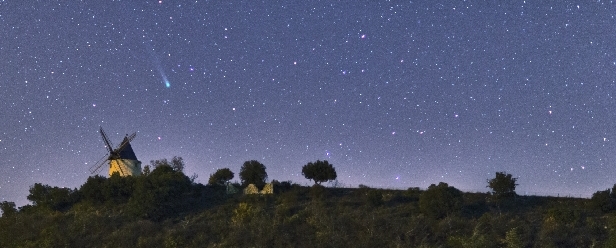
The past few weeks have been an unusually active time for comet watchers as four comets were visible simultaneously with binoculars: ISON, Lovejoy, Encke, and LINEAR.
Although less known than ISON, newly discovered comet C/2013 R1 (Lovejoy) is visible with naked eye in the northern hemisphere since November 2013 and many observers report it is outperforming ISON. New Lovejoy is not a sungrazing comet but it quickly became one of the stars of the year and its images, as you can see below, are amazing.
The name Lovejoy is already familiar to comet watchers but the only reference to famous Comet C/2011 W3 (Lovejoy) is its discoverer, Terry Lovejoy. Two years ago, Comet C/2011 W3 skimmed across the Sun's edge about 140 000 km above the surface (late December 15 and early December 16, 2011) furiously brightening and vaporizing as it approached the Sun. It is still the brightest sungrazing comet that SOHO has ever seen, with a nucleus about twice as wide as a football field. It unexpectedly survived the pass and cruised out from behind the Sun some hours later. See it in SOHO's archive here. NASA Science News Story about it is here: Comet Lovejoy Plunges into the Sun and Survives.
C/2013 R1 (Lovejoy)
%20on%20Sep%209%202013.gif)
Image credit: NASA SSD/JPL.
After two nights of photographic observations with an 8-inch (20 cm) Schmidt-Cassegrain reflector, Terry Lovejoy announced the discovery of new comet on September 9, 2013. At the time, the comet was a faint midge of about 14.5 magnitude crossing the border between Orion and Monoceros. Subsequent observations by other amateur astronomers suggested it is a bit brighter, at 14.0. It had a small, condensed, coma.
The image below was taken on September 10:
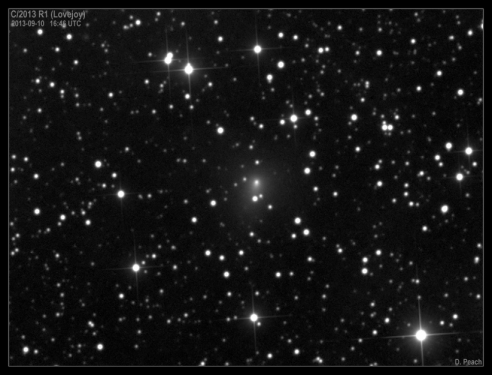
C/2013 R1 (Lovejoy) on September 10, 2013. Image copyright: Damian Peach
On November 9, 2013, well known astrophotographer Damian Peach took its image as Lovejoy was nearing the edge of naked-eye visibility. The comet had a green coma and a visible tail.
It was about 0.5 AU from our planet and 1.2 AU from the Sun sweeping past well known star cluster M44, the Beehive in Cancer. Yellowish bright star Delta Cancri is near the bottom of the frame:
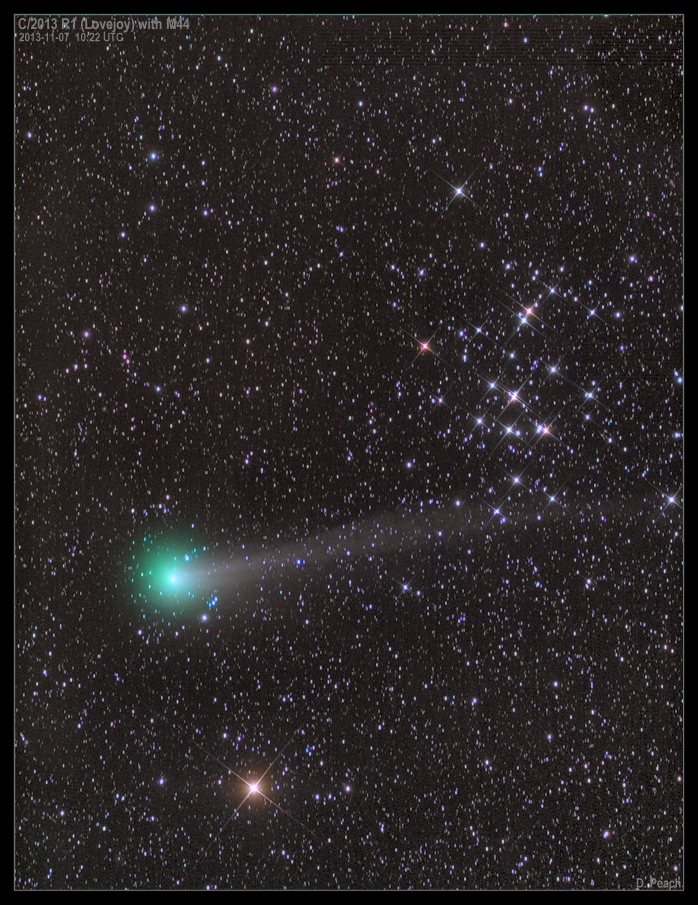
Image copyright: Damian Peach. This image was featured in NASA's Astronomy picture of the Day on November 9, 2013.
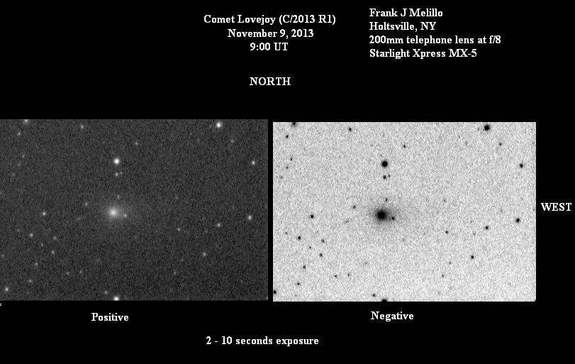
C/2013 R1 (Lovejoy) on November 9. 2013 Image credit: Frank Mellilo
This newly discovered Lovejoy crossed the celestial equator on October 14, 2013 and became a better northern hemisphere object. From that point on, great images started coming in.
Below is Lovejoy's short timeline, selected images by various photographers and its calculated path as it approaches its perihelion on December 22, 2013.
On November 15, Damian Peach took this image :
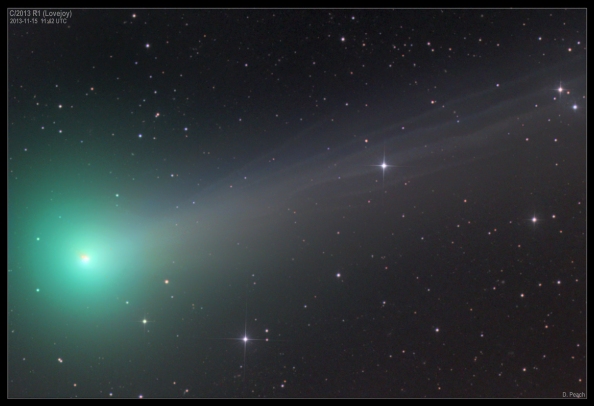
C/2013 R1 (Lovejoy) on November 15, 2013. Image copyright: Damian Peach
On November 19, Lovejoy made its close approach with Earth and passed within 59.4 million km (36.9 million miles, 0.3967 AU) of our planet. The news was outshined by Comet ISON.
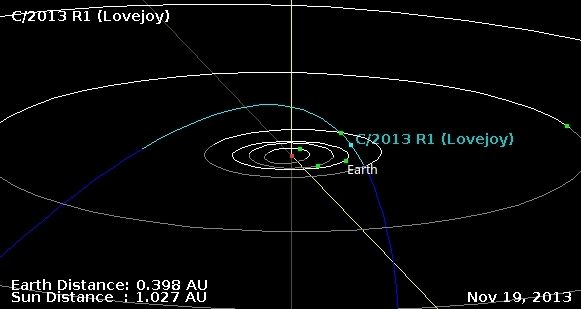
Image credit: NASA SSD/JPL. Edit: The Watchers
On November 25, Comet Lovejoy was captured on this spectacular image passing well in front of spiral galaxy M63. The image was featured on NASA's Astronomy Picture of the Day on December 2. The comet had a large green coma and a beautifully textured ion tail.
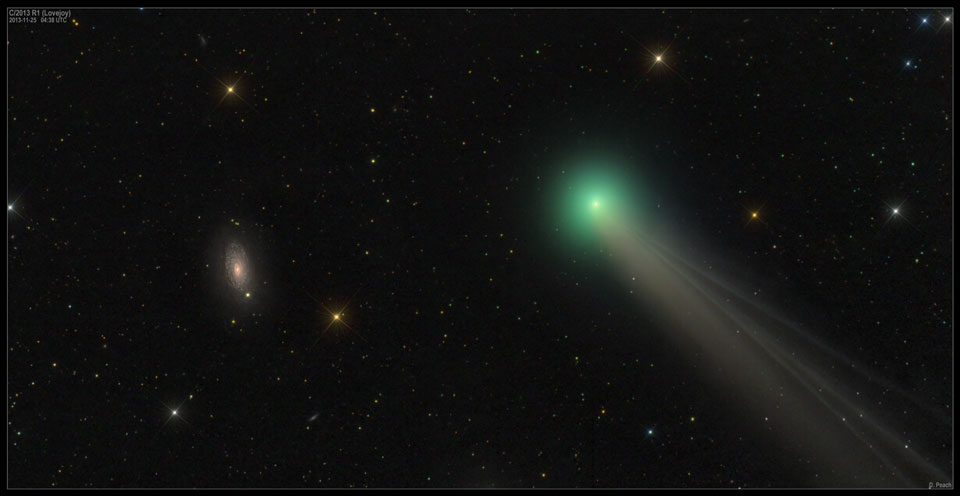
Comet Lovejoy on November 25 2013. Image copyright Damian Peach
From November 28 – December 4, 2013, Lovejoy was in the constellation Boötes. On December 1, 2013, it passed the star Beta Boötis and from December 4 until December 12 it will be in the constellation Corona Borealis.
Changes in Lovejoy's tail
On December 4 astrophotographer Kouji Ohnishi (Nagano, Japan) took this image and reported he could see big changes in Lovejoy's tail in less than an hour of monitoring:
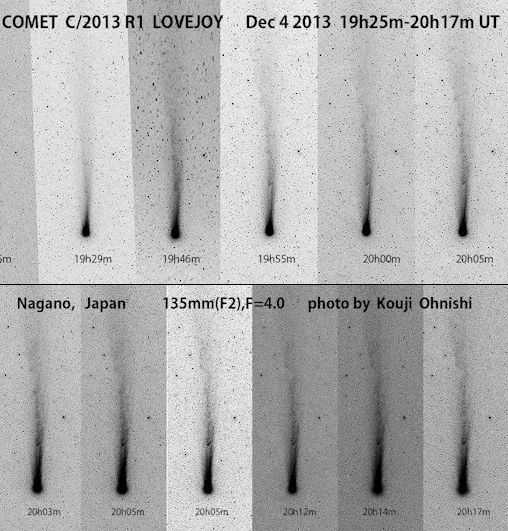
Taken by Kouji Ohnishi on December 4, 2013 @ Disturbance of ion tail of Comet Lovejoy. Image via SpaceWeather
Michael Jäger saw the same "disconnection event" from his observatory in Masenberg, Austria, on December 5th. The disturbance could be caused by a gust of solar wind or perhaps an episode of vigorous outgassing in the comet's core:
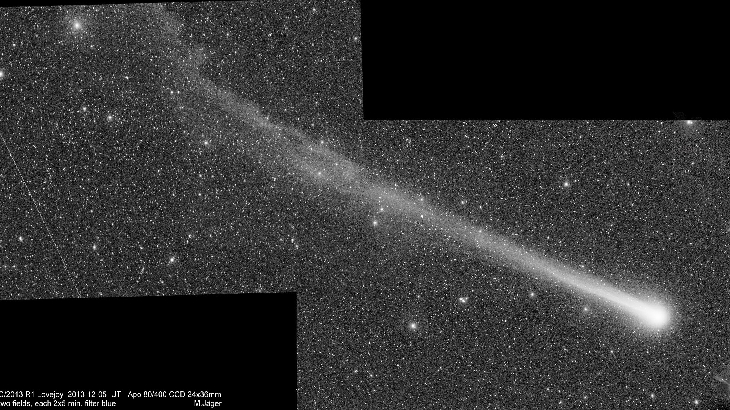
Image taken by Michael Jäger on December 5, 2013 @ Masenberg Austria. Via SpaceWeather
On December 6 astronomer Jens Hackmann took this impressive image from observatory in southern France:
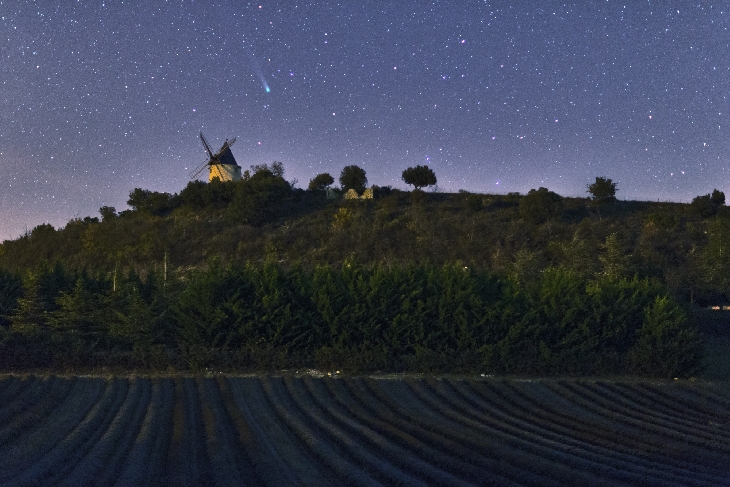
Taken by Jens Hackmann on December 6, 2013 @ St.-Michel lObservatoire, southern France. Via SpaceWeather. Caption: "Comet Lovejoy as seen from southern France (St.-Michel lObservatoire). I used my Canon EOS dSLR with a 85 mm telephoto lens. Exposure time was 6 sec at an ISO speed of 3.200. The comet was visible to naked eye."
The following image of Comet Lovejoy was taken on December 7 by Giorgia Hofer, Italy:
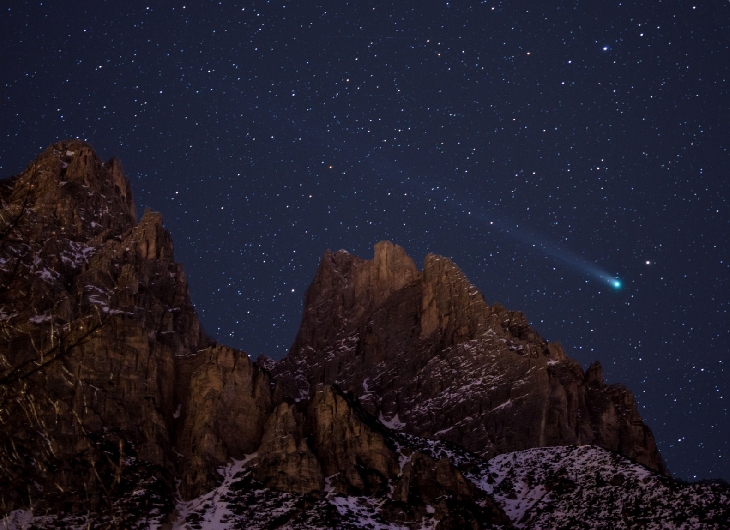
Taken by Giorgia Hofer on December 7, 2013 @ Cortina dAmpezzo – Italy. Via SpaceWeather. Caption: Comet Lovejoy over Monte Cristallo (Dolomites – Italy), on morning (05:00 ut) of december 7th. Comet ISON field: no comet visible… 🙁
On December 8, Dr Paolo Candy from Ci.A.O. Cimini Astronomical Observatory in Italy posted this image:
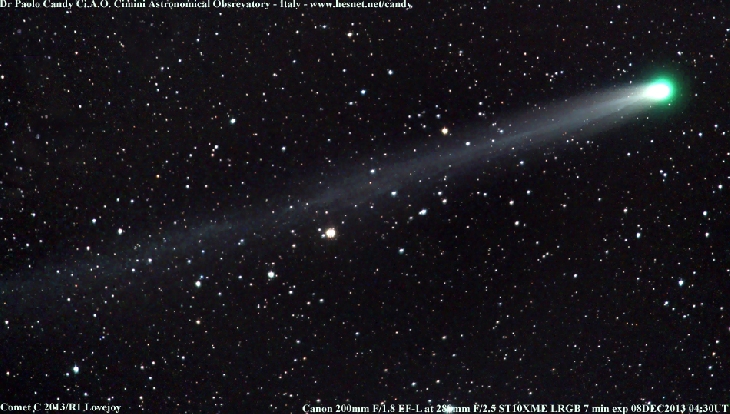
Taken by Dr Paolo Candy on December 8, 2013 @ Ci.A.O. Cimini Astronomical Observatory – Italy. Via SpaceWeather. Caption: The magnificent comet Lovejoy continues his run into space, leaving dust and ions scattered in the wind of solar particles … Canon 200mm F/1.8 EF-L at 280mm F/2.5 – ST-10XME LRGB 7 min exp 08DEC2013 04:30UT – Very very high humidity!
Comet Lovejoy will pass the star Zeta Herculis on December 14, 2013, and head toward its closest approach to the Sun. See its orbit diagram here.
Perihelion
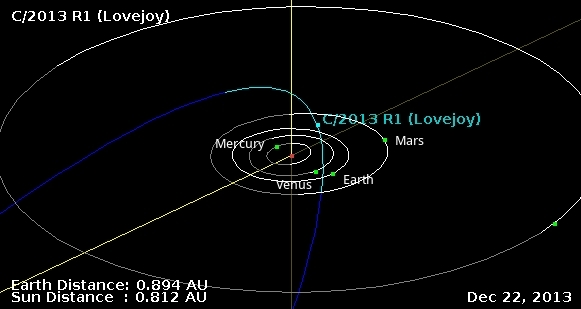
Image credit: NASA SSD/JPL. Edit: The Watchers
C/2013 R1 (Lovejoy) is expected to reach its perihelion (closest approach to the Sun) on December 22, 2013, at a distance of 121 million kilometers (75 294 203 miles, 0.81 AU) from the Sun. After that it is expected to continue on its journey back to the outer Solar System but should remain a good sight in binoculars for another few weeks.
Based on latest orbital calculations, Comet Lovejoy will not come back for at least 7 000 years.
Latest observations
Lovejoy is now about as bright as a 4th magnitude star. It is visible to the unaided eye from dark places and is an easy target for backyard telescopes even in urban areas. It rises in the east just before the morning Sun. Map below will help you located it. You can generate its ephemeris here.
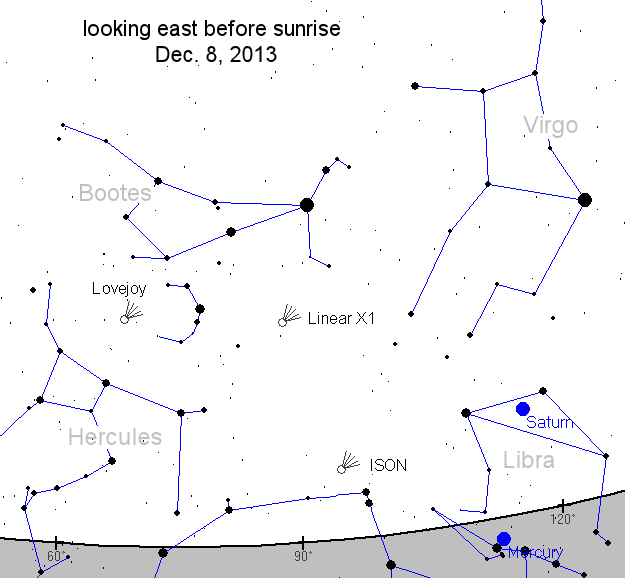
Where to spot it. Sky maps by SpaceWeather: December 8, 9.
- If you happen to take images of Comet Lovejoy, and want to share them with us, use this form.
Featured image Jens Hackmann on December 6, 2013 @ St.-Michel lObservatoire, southern France.

Commenting rules and guidelines
We value the thoughts and opinions of our readers and welcome healthy discussions on our website. In order to maintain a respectful and positive community, we ask that all commenters follow these rules:
We reserve the right to remove any comments that violate these rules. By commenting on our website, you agree to abide by these guidelines. Thank you for helping to create a positive and welcoming environment for all.